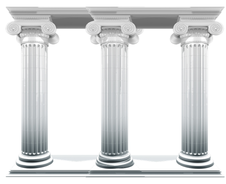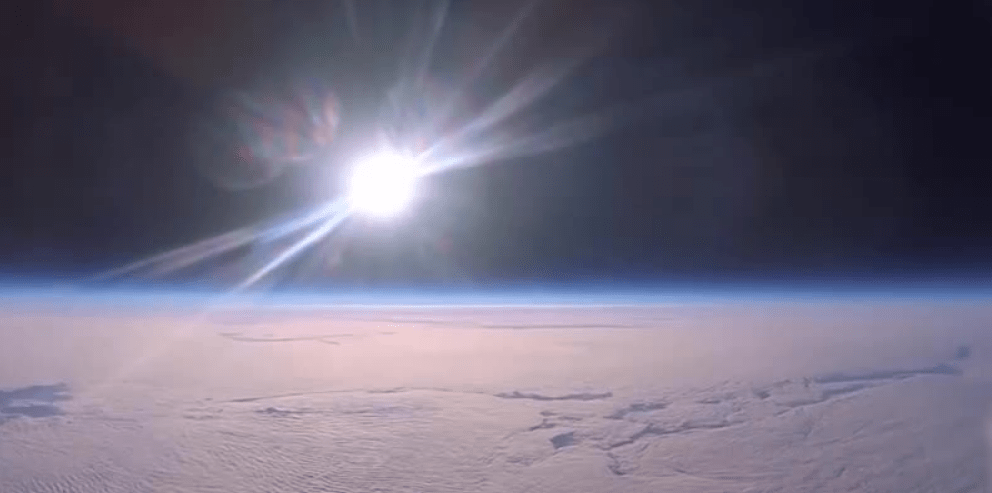God designed the heavens and earth to communicate to us an idea of his character and power.
The heavens declare the glory of God; And the firmament shows His handiwork. Psalm 19:1 (NKJV) For since the creation of the world His invisible attributes are clearly seen, being understood by the things that are made, even His eternal power and Godhead, so that they are without excuse, Romans 1:20 (NKJV)
An accurate understanding of his creation will foster a better understanding of God; whereas, a faulty or false model will not reflect God properly. Therefore, it is with the fear of the Lord that we examine the scriptures to see how they describe this place we call earth.
The Bible never uses the world “planet” or “globe” as a synonym for earth. Those terms come from astrophysicists who reject the biblical testimony.
The only “proof” of a spherical earth that most people offer are are CGI photos and video supposedly taken from “outer space” by NASA and other space agencies. Others the phenomena surrounding eclipses to try to demonstrate that the earth and other heavenly bodies are solid or gaseous spheres.
We need to keep in mind that if our presuppositions are incorrect, all our so-called proofs will be likewise incorrect. People who accept the biblical testimony regarding the shape of the earth have come up with other ways to explain heavenly occurrences. As notable astrophysicists have pointed out, what we observe in the heavens can be explained in more than one way.
Simply by doing physical experiments on earth, one cannot prove the curvature of the earth because it does not exist.
Once we know that the earth is a plane, our next task is to begin to try to figure out how things really work. Because we have been taught a false paradigm for the past 500 years, we are way behind in learning about the true nature of things. The firmament is an area that needs much more research because little is known about it, but the Bible gives us some information. We may never know all we want to know because God never told us to rule over that domain.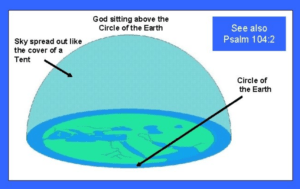
Those who claim that they have been to “outer space” and observed first-hand the suspendedspherical earth, which is always perfectly round, notwithstanding Neil deGrasse Tyson’s claim that it is an oblate pear-like shape, often use the word “fragile” to describe the earth and its atmos. I personally believe this is by design to conjure fear for our continued existence, which is all part of Satan’s grand scheme of deception. Those who do Satan’s bidding do not want us to know that we are safely enclosed in the solid dome called the firmament and watched over by our Creator.
The mention of God’s creating the firmament in Genesis Chapter One confronts us with an unavoidable choice. Will we believe what the Bible says or what modern astrophysicists and NASA tell us? “Did God really say” (Genesis 3:1) that the firmament is a real structure above the earth in which the sun, moon, and stars were placed on day four of creation?
If we choose to believe what scientists tell us, we relegate the Bible account to the realm of myth, which has no relevance to the “real world.”
Sadly, at the present time, it seems that most of us have put our faith in science, making it a false god.
The word translated as “firmament” in the KJV and NKJV is the Hebrew word raqia, which is rather vaguely rendered as “sky” or “expanse” in other versions to accommodate the generally accepted heliocentric model.
The word “firmament” better communicates something of its true nature – an immense and firm vaulted dome-like structure made of something like crystal (Ezekiel 1:22) or very strong glass.
In Genesis 1:8, God called the firmament (raqia) heaven (shamayim). God used the firmament to separate the waters (mayim) below from those located above it.
Thus God made the firmament, and divided the waters which were under the firmament from the waters which were above the firmament; and it was so. Genesis 1:7 (NKJV)
So above the firmament there was and currently is (Psalm 148:4) water. The shamayim (heavens) contain mayim (waters). The waters above did not disappear after the flood, as some expositors claim.
Therefore, the firmament is hard and strong enough to support the enormous weight of untold amounts of water which are above it, some of which apparently were released upon the earth in judgment during the great flood. (Genesis 7:11-12)
There is no reason to suppose that those waters were not replaced. In fact, there appears to be a giant system of water above and below the earth, which ancient Hebrews believed looked something like the attached image. 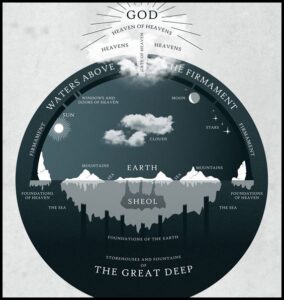 Sadly, the translators of my beloved New Living Translation, in their attempt to explain difficult concepts in modern language and terms, took the liberty to translate mayim as “water vapor.” Often they do a good job of translating idea for idea, especially when it comes to helping us understand theological terms such as justification, but in this case they did us a great disservice. Mayim means waters or a flood, not vapor. (This is why I advise people to read dynamic equivalency translations such as the NLT alongside a version that gives a literal rendering, such as the NKJV, NASB, or ESV.)
Sadly, the translators of my beloved New Living Translation, in their attempt to explain difficult concepts in modern language and terms, took the liberty to translate mayim as “water vapor.” Often they do a good job of translating idea for idea, especially when it comes to helping us understand theological terms such as justification, but in this case they did us a great disservice. Mayim means waters or a flood, not vapor. (This is why I advise people to read dynamic equivalency translations such as the NLT alongside a version that gives a literal rendering, such as the NKJV, NASB, or ESV.)
Almost all translators choose words for raqia (firmament) that are more palatable to our modern “scientific” heliocentric worldview. Check it out for yourselves. The NASB, ESV, and NET, my usual “go to” versions for a literal rendering of the Bible, all use the word “expanse,” which communicates absolutely nothing of the hard and strong nature of the firmament, but provides the heliocentrist with complete liberty to superimpose that view, complete with unlimited expanses of “outer space,” upon the Scripture. The KJV and NKJV are faithful to the Hebrew and use the word “firmament” to communicate its solidity and strength.
Can you, with Him, spread out the skies, Strong as a molten mirror? Job 37:18 (NASB95)
So a proper understanding of the heavens must include the presence of a solid firmament separating waters from waters, in which God placed the sun, moon, and stars. No one as yet knows much about the firmament. Some tests indicate that rockets encounter something at about 72 miles; although, the ISS says it maintains a lower earth orbit at above 200 miles. Some have triangulated the sun and place it at about 3000 miles away, which would require it to be much smaller than what we have been told. Perhaps we were never intended to know all about it. God did not tell us to have dominion over the heavens, but only the earth.
As for me, when I stand before God one day, I would rather he tell me that I took him too literally than have him question why I doubted or altered his words.
Jesus replied, “Your mistake is that you don’t know the Scriptures, and you don’t know the power of God. Matthew 22:29 (NLT)
Isaiah provides us with a snapshot of God’s position above the firmament, looking down upon the “circle” of the earth.
It is He who sits above the circle of the earth, And its inhabitants are like grasshoppers, Who stretches out the heavens like a curtain, And spreads them out like a tent to dwell in. Isaiah 40:22 (NKJV)
Those who insist that the earth is a globe sometimes refer to the above verse as a “proof text.” The 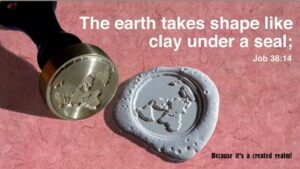 word translated “circle” means drawn as a circle, as one would by using a compass. The word “ball” is used in Isaiah 22:18; so, the prophet knew the difference between a circle and a ball. The image to the right could be thought us as a circle with edges as would be formed by pressing a circular seal into wax, which was a word picture used in Job 38:14, when God himself is talking about his creation.
word translated “circle” means drawn as a circle, as one would by using a compass. The word “ball” is used in Isaiah 22:18; so, the prophet knew the difference between a circle and a ball. The image to the right could be thought us as a circle with edges as would be formed by pressing a circular seal into wax, which was a word picture used in Job 38:14, when God himself is talking about his creation.
It is changed like clay under a seal... Job 38:14a (LEB)
Going back to the verse from Isaiah above, the heavens (which was the name given to the firmament) are stretched out like a curtain and spread out like a tent. The most likely kind of tent would be a circular dome-like tent, similar to a yurt.
Amos 9:6 in the NASB provides us with wonderful picture of the firmament.
The One who builds His upper chambers in the heavens And has founded His vaulted dome over the earth, He who calls for the waters of the sea And pours them out on the face of the earth, The LORD is His name. Amos 9:6 (NASB95)
God placed his throne and “upper chambers” above the firmament. I will look at this in another article.
The Hebrew word for “vaulted dome” is aguddah, which means “bands fitted together.” For some reason, the NASB translators are the only ones that chose to translate aguddah to describe the firmament as a vaulted dome above the earth, but I am glad they did. On the positive side, the other versions make the connection that the upper “strata” (NKJV) is attached to the earth. Putting it together, we understand the vaulted dome of the firmament is made of entwined “bands” attached firmly to the earth. It is the most immense structure in creation, as far as we are told. No wonder it took all of day two to create it.
Bless the LORD, O my soul! O LORD my God, You are very great: You are clothed with honor and majesty, 2 Who cover Yourself with light as with a garment, Who stretch out the heavens like a curtain. 3 He lays the beams of His upper chambers in the waters, Who makes the clouds His chariot, Who walks on the wings of the wind, 4 Who makes His angels spirits, His ministers a flame of fire. 5 You who laid the foundations of the earth, So that it should not be moved forever, Psalm 104:1–5 (NKJV)
Those who hold that the earth is a stationary plane believe the firmament extends beyond the ring of ice that contains the oceans, which is falsely depicted as the continent of Antarctica on the globe. Interestingly, a page from the Encyclopedia Americana (1958 edition) references the existence of the firmament in that area of the earth. Click here to see a video on YouTube.
The firmament is an extremely vast structure that extends over an currently unknown area of the plane earth up to an unknown altitude.
As the heavens for height and the earth for depth, So the heart of kings is unsearchable. Proverbs 25:3 (NKJV)
Some think a bottom layer may be about 73 miles high, based on interesting video evidence. The following video shows lightning sprites at about that altitude illuminating what appears to be the firmament above them. Such evidence is not a “proof,” however. The “proof” is God’s Word.
The Bible says that God placed the sun, moon, and stars in the firmament on Day Four of creation.
Then God said, “Let there be lights in the firmament of the heavens to divide the day from the night; and let them be for signs and seasons, and for days and years; 15 and let them be for lights in the firmament of the heavens to give light on the earth”; and it was so. 16 Then God made two great lights: the greater light to rule the day, and the lesser light to rule the night. He made the stars also. 17 God set them in the firmament of the heavens to give light on the earth, 18 and to rule over the day and over the night, and to divide the light from the darkness. And God saw that it was good. 19 So the evening and the morning were the fourth day. Genesis 1:14–19 (NKJV)
This passage shows why it is impossible to uphold the accuracy of the Bible while believing in the heliocentric model, which derives from the Big Bang evolutionary theory of the formation of the “ever expanding” universe.
The Bible tells us that they earth and seas were created on day one, over which God erected the vaulted dome of the firmament on day two, in which he placed the heavenly luminaries on day four. The sun follows a circuit over the stationary plane of the earth. (Psalm 19:6) Both the sun and moon are lights, according to the Bible. The stars are luminaries in the firmament, not distant suns.
The firmament contains everything that NASA and modern astrophysics tell us is located in what they call “outer space.” The Bible only refers to outer darkness, the place where the disobedient will go after the judgment. NASA’s “outer space” is a fiction, and no one is going there, except, perhaps, after being judged by our Lord. Everything that NASA claims is in outer space is located in the firmament. What we see are computer generated images derived from “data.”
If we reject the reality of the biblical firmament, it opens us to false cosmologies that contradict God’s Word. Belief in the literal firmament is a huge key to understanding the world in which we live.
